
Digital Mapping Techniques '01 -- Workshop Proceedings
U.S. Geological Survey Open-File Report 01-223
The U.S. Geological Survey National Paleontological Database
By Bruce R. Wardlaw, Nancy R. Stamm, and David R. Soller
U.S. Geological Survey
926A National Center
Reston, VA 20192
Telephone: (703) 648-5288
Fax: (703) 648-6953
e-mail: bwardlaw@usgs.gov
INTRODUCTION
As an integral part of the Geologic Mapping Act, and under the umbrella of the National Geologic Map Database (NGMDB) project, the USGS is developing a national paleontologic database. It is a research and a mapping-support tool, and is designed to be used in concert with other NGMDB databases (see related papers in these Proceedings).
The USGS has a long and storied history of paleontologic collections cited in classic monographs, professional papers, but also a less known dataset amassed over 110 years of informal reports on fossil collections. These collections were submitted by government, industry, and private individuals and field teams and reported on by paleontologists employed by the Survey. It was a natural conclusion in developing a prototype for a paleontologic database to incorporate the data from both the classic formal reports and the abundant informal reports. The informal reports, dating back to 1889, have been the subject of various attempts at digitization since 1970. All previous attempts failed. Only one complete paper set of the reports now exists. So, in addition to the congressional mandate to develop a paleontologic database, there was the added incentive to save this large informal dataset before it was lost. These informal reports, called "E&R's," for Examine and Report on Referred Fossils, typically follow the form shown in Figure 1. To preserve this data, each report is being scanned and the digital copy will become part of the database. Pertinent information needed to fill out the standard locality and specimens tables is then taken from the report. The quality of the locality data in these reports varies from detailed descriptions that can be fully integrated into a digital map database (as in the example in Figure 1) to those that we will be lucky to place in the proper 1:100,000 quadrangle.
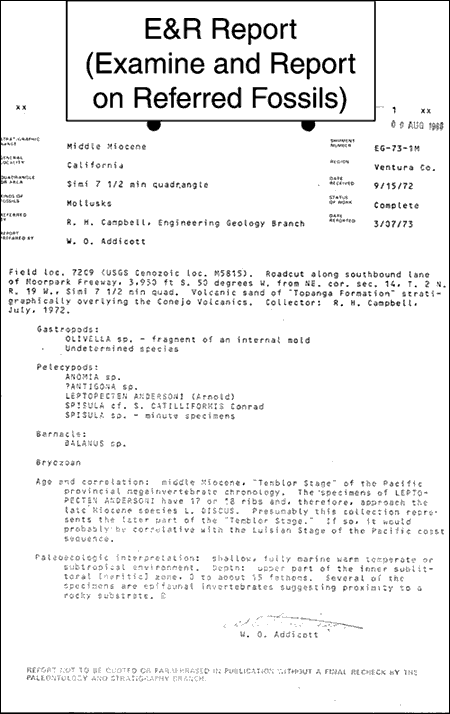
Figure 1. Example of an E&R Report.
|
Additionally, the USGS has traditionally emphasized the practical application of paleontology to solve earth science problems, so the stratigraphic context of each fossil collection is highlighted. To this end, measured sections, range charts, and biostratigraphic interpretations are included in the dataset.
Representatives of figured specimens from each quadrangle are also maintained in the database and tied to the museum repository numbers so that the user can find the specimen indexed.
These various factors drove the formation of the data model and the particular structure of USGS national paleontologic database, Paleodata.
The data model (fig. 2) incorporates the seemingly disparate relational tables discussed above of the E&R reports, measured sections, biostratigraphic information, and figured specimens along with locality and specimen identification.
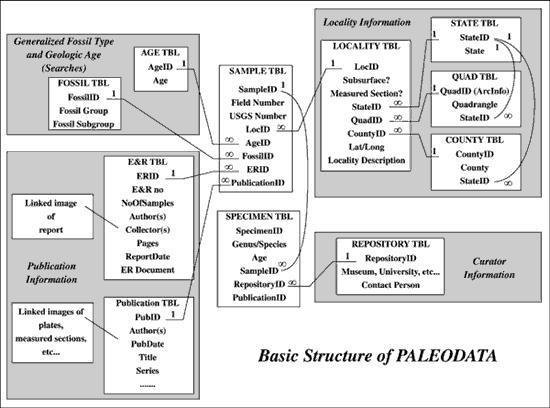
Figure 2. The Data Model: Basic structure of Paleodata.
|
We are constrained by the data we have at hand and the nature of our business. We do not believe that the design of our paleontologic database is more correct or superior to any other. On the contrary, we feel it is important to show the status of its development, to encourage discussion that might lead us toward an improved database.
PALEODATA SEARCH PAGE
Paleodata searches are based on geologic age, fossil group, geographic area or E&R (fig.3).
The geologic time scale accepted by the USGS and used for Paleodata is that currently accepted by the International Commission on Stratigraphy (Remane, 2000), and is subject to change as the Commission ratifies international boundaries that are currently being proposed.

Figure 3. The Paleodata Search Page with Invertebrate category enlarged.
|
The fossil groups we use are those developed through compromise with federal land managers. Federal land managers are interested in protecting all vertebrate fossils and tracks and trails and have a much lesser concern for invertebrate or plant fossils. So, these are convenient groups to make first-cut fossil assessments on maps. The fossil subgroups we use are simply generated by those for which we have a lot of data, and not from grand, apriori schemes of fossil classification. It should be noted that Palynomorphs (Plants) are all organic-walled plant microfossils including dinocysts, acritarchs, pollen, and spores. We do not have enormous collections or reports of crinoids, blastoids, cystoids, or echinoids, so these are listed in one category, echinoderms. We use the common names for most groups and include related groups within the search topic (For instance, fossil hydrozoans would be found with "Corals"). Conodonts, for which we have a wealth of data, were separated from fish (where they belong), because of the amount of data and because many of our users prefer to search for conodonts and not other fish fossils. We will most likely increase our subcatagories as the database becomes more robust.
The geographic search is by state, counties or 100k quadrangle.
The E&R search requires some knowledge of the E&R or the former Paleontology and Stratigraphy Branch of the USGS, in order to search by report number, author, sample (field) number, or USGS collection number.
A KANSAS MAP SEARCH
Figures 4-9 show the various information that will be available from a map search. Selecting the Manhattan 1:100k quadrangle (fig. 4) will produce a map with fossil localities marked and a pop-up box showing the locality identification number and (or) sample numbers (fig. 5). In the case of locality 13510 there are two samples from the same location. In the case of BMW-08, it is a measured section with numerous samples, as shown in the locality information tables retrieved by double-clicking on the locality. Clicking on the sample will bring up the fossil specimen list for the locality (figs. 6, 8). Clicking on any of the highlighted specimens will bring up an image of the fossil which are variously catalogued to each map (e.g., fig. 7). In the case of brachiopods, all the brachiopods illustrated from the Manhattan quadrangle from Mudge and Yochelson (1962) are on one plate. Bracketed names following a specimen name are modern generic designations. All specimens in the database maintain their original name from the publication cited. In case of the measured section, BMW-08, the specimen list for a specific sample can lead to either the measured section (by clicking on the section id) or the specimens (by clicking on a highlighted specimen, fig. 9). The samples listed on the measured section lead back to the specimen list and to the figured specimens. The conodonts are organized into illustrated specimens from a given sample.

Figure 4. Search of 1:100,000 scale maps of Kansas, in this case highlighting the Manhattan quadrangle.
|
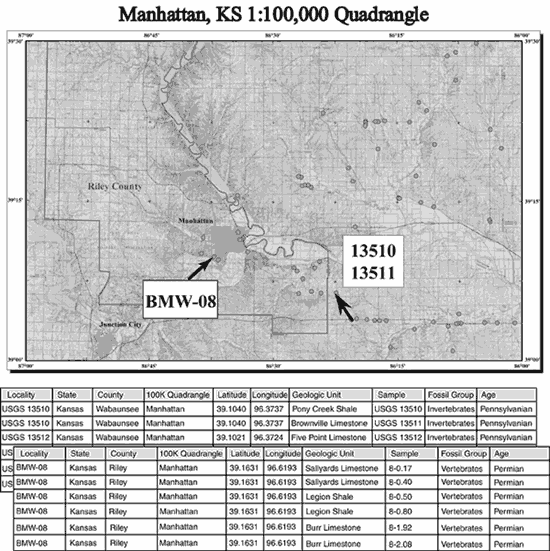
Figure 5. Manhattan, KS 1:100,000 Quadrangle Fossil Localities and examples of Locality Information Tables for two sites.
|
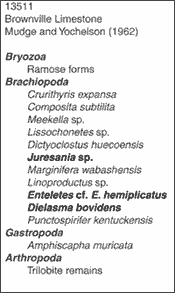
|
|
Figure 6. Fossil Specimen List for USGS Locality 13511.
|
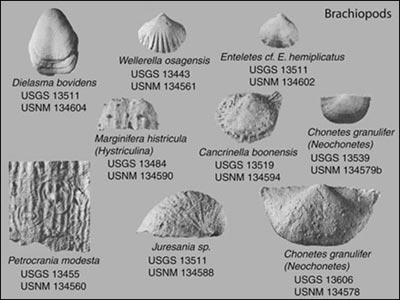
Figure 7. Figured Specimens of Brachiopods from the Manhattan 1:100,000 Quadarangle with USGS Locality Number and USNM (United States National Museum) Repository Number (from Mudge and Yochelson, 1962).
|
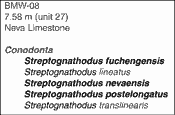
|
|
Figure 8. Fossil Specimen List for Sample 8-7.58, bed 27, 7.58 m above base of measured section BMW-08 of Boardman and others (1998). Conodonts are a fossil subgroup of Vertebrates.
|
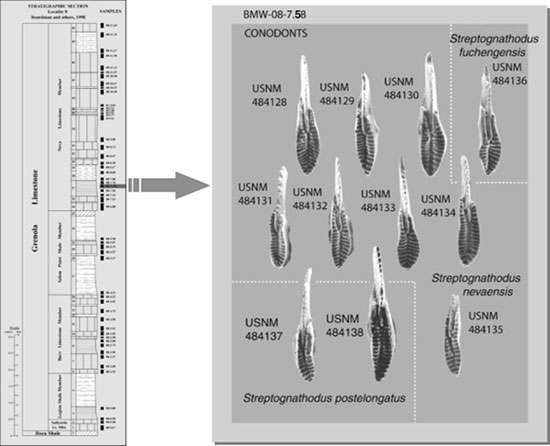
Figure 9. Columnar Section of measured section BMW-08 showing samples and figured specimens of conodonts from sample BMW-08-7.58 with USNM Repository Numbers.
|
LINKS TO RELATED USGS DATABASES
Both the NGMDB¹s Geolex (the online Geologic Names Lexicon) and the geologic Map Catalog will be accessible from Paleodata. Geolex can be accessed from the National Geologic Map Homepage or the user will be able to go directly to the Geolex search page from any stratigraphic name or columnar section in Paleodata (figs. 10-12). In the example used here, the Red Eagle Limestone, which contains the Pennsylvanian-Permian boundary is selected. The Map Catalog is accessed by clicking back to the National Geologic Map Homepage and then searching for the available geologic maps (here by county in Kansas, figs. 13-15).
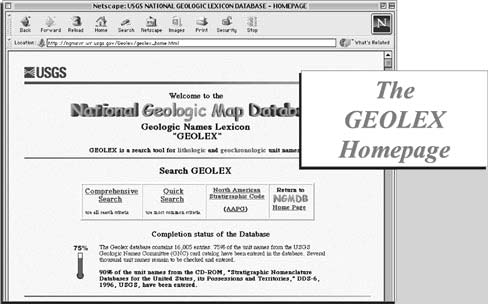
Figure 10. The Geolex Homepage.
|

Figure 11. Geolex Quick Search page. A Comprehensive Search page also is available. The Geologic unit selected to search for is "Red Eagle".
|
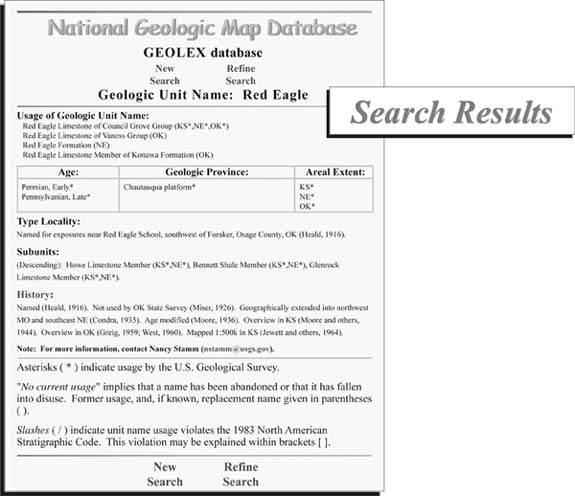
Figure 12. Geolex Search Results for Geologic Unit Name: Red Eagle.
|
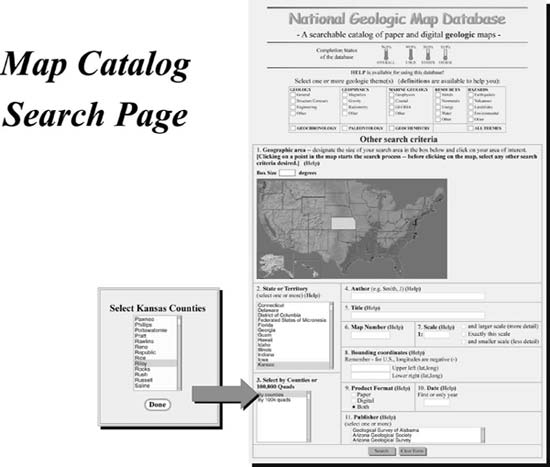
Figure 13. The Map Catalog Search Page. The state "Kansas" is selected (highlighted on map of U.S.) and the county "Riley" is selected from drop down menu of Kansas Counties.
|

Figure 14. Available geologic map data including online digital geologic map of Riley County.
|

Figure 15. Geologic Map of Riley County available from the Kansas Geological Survey that includes columnar section with Red Eagle Limestone. Lithic representation and its map distribution may be determined from the map.
|
A TEXAS MAP
The Guadalupe Peak 1:100k quadrangle was also examined in development of Paleodata because it contains a wealth of fossil data from a variety of publications and informal reports. Also, it was instrumental in developing sequence stratigraphy and contains a National Park. National Parks pose a delicate problem in education and preservation, because fossil collecting is tightly controlled. As alluded to earlier, most federal land managers want to control vertebrate fossil site information. To accommodate this concern, we separate out large vertebrate fossil sites and only identify them to the 1:100k quadrangle and refer the user to the local land manager for further information. Fortunately, in the Guadalupe Peak quadrangle, the only common vertebrate fossils are conodonts and other fish debris (scales and teeth), which are still treated much like invertebrate fossils. Figures 16 and 17 show the quadrangle and representative information tables. Figures 18-20 show a glimpse of some of the graphic fossil data available. Brachiopods (fig. 21) are particularly diverse in the Permian (the time period represented by most of the rocks in the Guadalupe Peak Quadrangle) and show numerous morphologies including coral-like and oyster-like forms. Guadalupe Mountains National Park is the first US park to have established international boundary stratotypes, and we took it as a challenge to serve this information along with other fossil data (fig. 22).
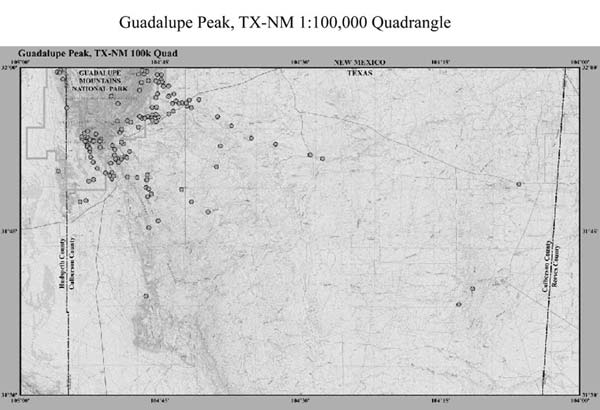
Figure 16. Guadalupe Peak 1:100.000 Quadrangle Fossil Localities.
|
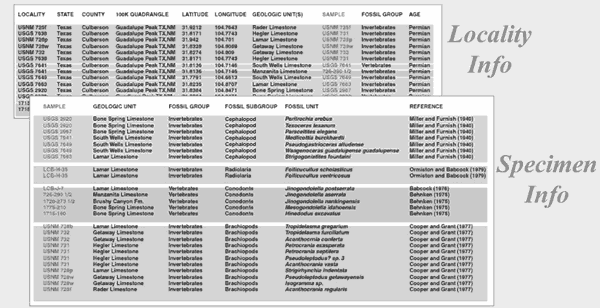
Figure 17. Examples of Fossil Locality Information Tables and Specimen Information Tables for the Guadalupe Peak Quadrangle.
|

|
|
Figure 18. (Top) Microphotograph of Fusulinid species in the database (from Wilde, 1986).
|
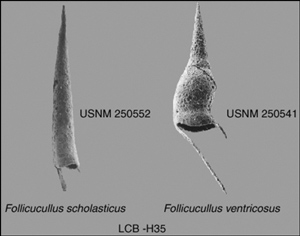
|
|
Figure 19. (Bottom) Microphotographs of Radiolarian species holotypes from Guadalupe Peak Quadrangle (from Ormiston and Babcock, 1979).
|
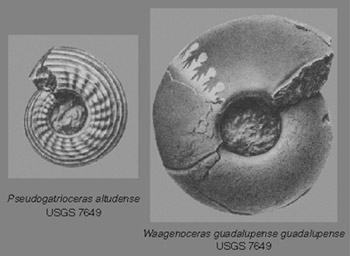
|
|
Figure 20. Specimens of ammonoids originally collected by Girty in the early 1900's and described by Miller and Furnish (1940).
|
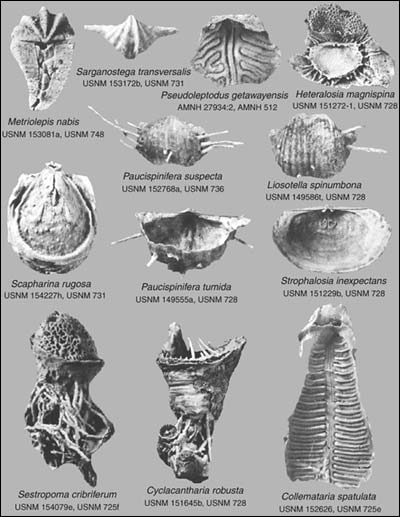
Figure 21. Photographs of holotypes and topotypes of Brachiopod species from the the wealth of material described by Cooper and Grant (1972-1977). Several hundred specimens from the Guadalupe Peak Quad. are illustrated in those publications. Only one representative specimen (usually the holotype) of each species named from material from the Guadalupe Peak Quadrangle will be digitally served in Paleodata.
|
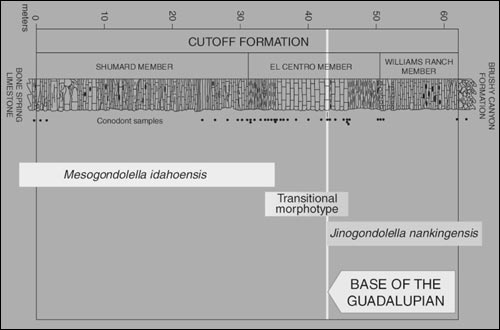
Figure 22. Guadalupe Mountains National Park (within the Guadalupe Peak 1:100k Quadrangle) contains the GSSP (Global Stratotype and Stratigraphic Point) for the internationally recognized Middle Permian (Guadalupian and its constituent stages, Roadian, Wordian, and Capitanian). This information along with the defining ranges of conodonts are also included in Paleodata. Here, the base of the Guadalupian is defined in a section in Stratotype Canyon by the first appearance of specimens which retain the characters of Jinogondolella nankingensis in adult forms.
|
REFERENCES
Boardman, D.R., II, Nestell, M.K., and Wardlaw, B.R., 1998, Uppermost Carboniferous and lowermost Permian deposition and conodont biostratigraphy of Kansas, USA, in Jin, Yugan, Wardlaw, B.R., and Wang, Yue, eds., Permian Stratigraphy, Environments and Resources, Volume 2: Stratigraphy and Environments: Palaeoworld 9, p. 19-32.
Cooper, G.A., and Grant, R.E., 1972, Permian brachiopods of West Texas, I: Smithsonian Contributions to Paleobiology, no. 14, p. 1-232.
Cooper, G.A., and Grant, R.E., 1974, Permian brachiopods of West Texas, II: Smithsonian Contributions to Paleobiology, no. 15, p. 233-794.
Cooper, G.A., and Grant, R.E., 1975, Permian brachiopods of West Texas, III: Smithsonian Contributions to Paleobiology, no. 19, p. 795-1922.
Cooper, G.A., and Grant, R.E., 1976, Permian brachiopods of West Texas, IV: Smithsonian Contributions to Paleobiology, no. 21, p. 1923-2608.
Cooper, G.A., and Grant, R.E., 1976, Permian brachiopods of West Texas, V: Smithsonian Contributions to Paleobiology, no. 24, p. 2609-3160.
Cooper, G.A., and Grant, R.E., 1977, Permian brachiopods of West Texas, VI: Smithsonian Contributions to Paleobiology, no. 32, p. 3161-3370.
Miller, A.K., and Furnish, W.M., 1940, Permian ammonoids of the Guadalupe Mountain region and adjacent areas: Geological Society of America Special Papers, no. 26, 242 p.
Mudge, M.R., and Yochelson, E.L., 1962, Stratigraphy and paleontology of the uppermost Pennsylvanian and lowermost Pemian rocks in Kansas: U.S. Geological Survey Professional Paper 323, 213 p.
Ormiston, A., and Babcock, L., 1979, Follicucullus, new radiolarian genus from the Guadalupian (Permian) Lamar Limestone of the Delaware basin: Journal of Paleontology, v. 53, no. 2, p. 328-334.
Remane, J., 2000, International Stratigraphic Chart: Geneva, Switzerland, Division of Earth Sciences, UNESCO and International Union of Geological Sciences.
Wilde, G.L., 1986, An important occurrence of early Guadalupian (Roadian) fusulinids from the Cutoff Formation, western Guadalupe Mountains, Texas, in Moore, G.E., and Wilde, G.L., eds., Lower and Middle Guadalupian Facies, Stratigraphy, and Reservoir Geometries, San Andres/Grayburg Formations, Guadalupe Mountains, New Mexico and Texas: Permian Basin Section SEPM Publication no. 86-25, p. 65-68.
RETURN TO Contents
National Cooperative Geologic
Mapping Program | Geologic Division |
Open-File Reports
U.S. Department of the Interior, U.S. Geological Survey
URL: https://pubsdata.usgs.gov/pubs/of/2001/of01-223/wardlaw.html
Maintained by David R. Soller
Last modified: 18:24:44 Wed 07 Dec 2016
Privacy statement | General disclaimer | Accessibility






















